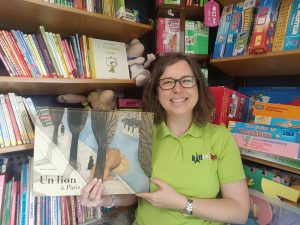 I saw this book being recommended a few times in LiPS (Languages in Primary Schools Facebook group) but it was not until I actually saw it for myself that I realised how beautiful and brilliant it was; it truly is a work of art. I finally decided to write a blog on it!
I saw this book being recommended a few times in LiPS (Languages in Primary Schools Facebook group) but it was not until I actually saw it for myself that I realised how beautiful and brilliant it was; it truly is a work of art. I finally decided to write a blog on it!
Click here to watch me introduce the book to you and see a couple of pages inside it.
Language of text: French
Type of text: picture book
Author or source: Beatrice Alemagna, published by autrement
Intended age of students: Key Stage 2/3
Source reference: 9782746708167
Approaches:
This is the (imaginary) story of how the statue of a lion on Place Denfert-Rochereau in Paris came to be.
It is best read to the pupils when they already have some knowledge about Paris, but could also be used as an introduction to the city, as all the children should have seen, if nothing else, the Eiffel Tower somewhere.
At first reading, I get the children to write down, in note form, where the lion goes; then I get them to look out for evidence/clues that the story in set in France (eg baguette, French writing).
I read it again and ask the children to decide and tell me in French, on each double page, how they think the lion is feeling: il va bien / il va mal / je ne sais pas.
The last time I read it all the way through I ask some prepared questions in English (suggested questions can be found here a lion in Paris locations and questions): for instance, where does he live at the beginning of the story? The children have to listen out for the cognate “savane”.
After we have learnt more about Paris, I show the pictures again to the children and they have to tell me, in French, where the lion is.
Rationale:
I want to use this book because it is a beautifully illustrated emotional story about feeling like a stranger in a new place and finding your place in the world.
It also gives you an insight into certain places in Paris and the French culture; it is content-rich.
Outcomes:
There is in the inside cover a simplified map of Paris showing where the lion goes. It could be used to practise directions in French.
With this story, the children will learn a lot about the city of Paris and its culture. They can do a lot more work to find out about it in more detail thanks to the map and activities on the Culturethèque website (see the bottom of this page for links and more).
At the end of their learning, the children (whether they have ever been there or not) could say what their favourite place in Paris is and why.
Topics or themes:
Paris; French culture; directions
Grammar:
any of your choice as the text is rich; I would personally focus on adjectives
How much time required:
1-2 lessons
You can buy this story in French on Amazon.co.uk by clicking here, or click here to buy the book in English at Little Linguist!
These links will give you even more ideas to exploit this amazing story of the lion: here, and here. I particularly like the idea of the children having a simple map of Paris in front of them and mapping out his journey. They could also do some art work in Beatrice Alemagna’s style.
For more free resources, the Institut Français de Londres, on their Culturethèque website, has shared a map of Paris and activities to go with it, which the children love. I have 5 printed copies of the map so we work on it in groups. You need to register here to access it online, but registration is free, and you will discover (if you do not know it already) a wealth or resources for the classroom! Click here to view the map once you have registered.
What is your favourite activity to do with your children when learning about Paris? Please share it in the comments below!

